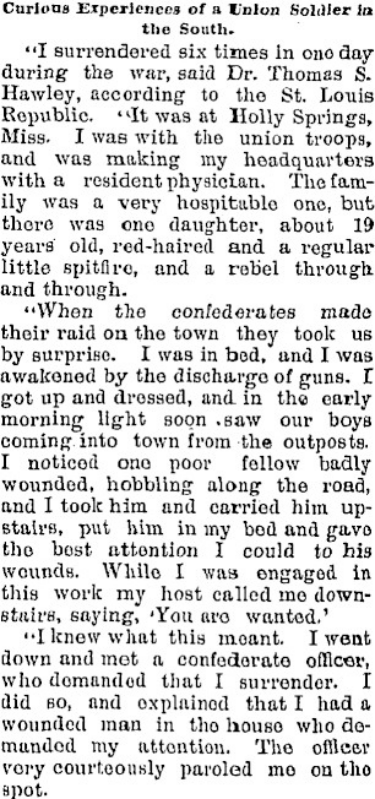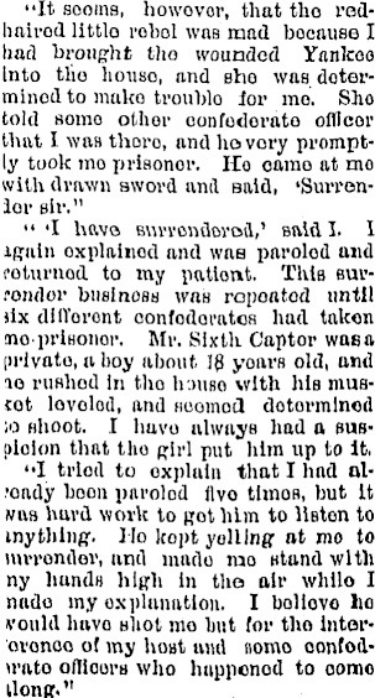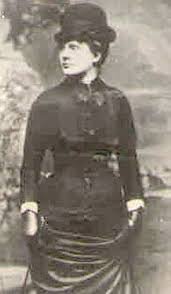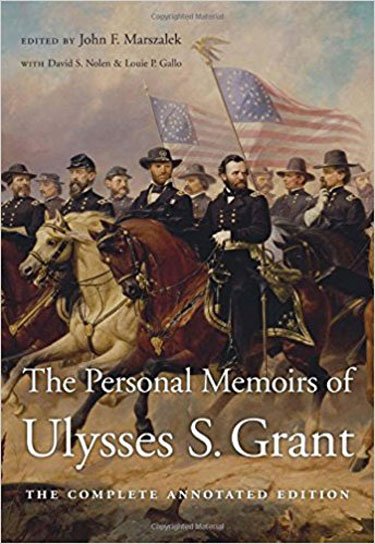Category Archive 'Ulysses Grant'
02 Apr 2021

“Cedarhurst”.
A neighbor forwarded a newspaper item involving some of our new house’s Civil War history.
Grant occupied Holly Springs in late November or early December of 1862. He made the town his new supply base for the Siege of Vicksburg.
On December 18th, Confederate General Earl Van Dorn raided the Union base at Holly Springs with 3500 cavalry, capturing 1500 Union troops and burning Grant’s supplies.
Lacking supplies, Grant was compelled to retreat for a time, and Vicksburg remained uncaptured until the following July.


The fiery rebel was Catherine Sherwood Bonner, who later became secretary and muse to Henry Wadsworth Longfellow and a successful novelist and regional author in her own right.

Many thanks to Bobby Mitchell!
17 Oct 2017


T.J. Stiles reviews Harvard University Press’s new annotated edition of Grant’s Memoirs.
At this distance, it’s hard to see the appeal of McClellan’s self-regard and concocted grandeur, because he sounds like an ass. It’s easier to like Grant. In his memoirs, Grant expresses his “rigorous distaste†for “ceremony, theater and oratory†(in the words of the historian John Keegan) by describing two generals of the war with Mexico, in which he fought bravely as a young West Point graduate. He admires the unaffected Zachary Taylor, who “dressed himself entirely for comfort,†in civilian clothes. But Winfield Scott “always wore all the uniform . . . allowed by law,†Grant observes: “dress uniform, cocked hat, aiguillettes†— loops of braid at the shoulder — “saber, and spurs.†Grant respects Scott’s ability but not his language, noting he was “not averse to speaking of himself, often in the third person, and he could bestow praise upon the person he was talking about without the least embarrassment.â€
Photo
That’s funny — almost Calvin Trillin funny — but we hear the bite. As modest and decent as Grant was, he appears to have clutched in his pocket a little squirming snake of resentment. After the Mexican War, he failed in the Army because of his secret shame, alcoholism, at a time when temperance was a major cultural force; he scrabbled hard in the years that followed, trapped in a desert of poverty. He returned to duty in the Civil War and won victory after victory, rising so high that Congress resorted to creating new ranks for him. His enemies retaliated by making his shame public, charging him with drunkenness. He felt the scorn of patricians like Henry Adams, who concluded he was “pre-intellectual . . . and would have seemed so even to the cave-dwellers.†Here and there, Grant shows how much it hurt. In cutting Scott, he goes beyond a mere lack of affectation into positive derision, mocking the pretensions of the refined society that mocked him.
“Perhaps never has a book so objective in form seemed so personal in every line,†Edmund Wilson observed, and I agree. But I disagree that Grant’s voice is “aloof and dispassionate.†Pain flickers behind the stolid pillars of the memoirs. He reflects his internal state off external surfaces, as with Taylor and Scott. Early on, he describes how as a boy he botched a negotiation for a horse — a telling anecdote, as financial failures agonized him — and the ensuing ridicule. “Boys enjoy the misery of their companions, at least village boys in that day did; and in later life I have found that all adults are not free from the peculiarity.â€
He armored himself with simplicity. Grant’s style is strikingly modern in its economy. It stood out in that age of clambering, winding prose, with shameless sentences like lines of thieves in a marketplace, grabbing everything in reach and stuffing it all into their sacks. Indeed, Grant adhered to Adams’s own instructions to the staff of the North American Review: “Strike out all superfluous words, and especially all needless adjectives.†Wilson observed, “Every word that Grant writes has its purpose, yet everything seems understated.â€
Authenticity is not perfect honesty, of course. Grant cannot always escape the impulse to put things in a favorable light, and he remembers his detractors. “The most confident critics are generally those who know the least about the matter criticized,†he writes. That defensive tone is uncharacteristic, though it’s revealing.
The Civil War rages for most of his book, and Grant proves an exemplary military narrator. He provides context clearly, even after he becomes general in chief, operating on a national scale. He makes his strategy sound like common sense, not genius. We feel his strength of will, from the dreadful first day of Shiloh to the great risk of his Vicksburg operation and beyond. He knew, too, how to shape the reader’s experience. He opens Chapter 50 with these two sentences: “Soon after midnight, May 3d–4th, the Army of the Potomac moved out from its position north of the Rapidan, to start upon that memorable campaign, destined to result in the capture of the Confederate capital and the army defending it. This was not to be accomplished, however, without as desperate fighting as the world has ever witnessed; not to be consummated in a day, a week, a month or a single season.†He delivers so much dread and anticipation with those words, at just the right place.
Grant’s preface alludes to the fact that he wrote as he was dying cruelly of throat cancer, after a swindler had bankrupted and humiliated him. Remarkably, that’s irrelevant to the text, which any writer could count as a triumph.
RTWT
24 Aug 2017


How much longer will Christopher Columbus look out over New York’s Columbus Circle?
New York Post:
Mayor de Blasio opened a historical can of worms Tuesday in his quest to rid the city of offensive monuments, ducking for cover when asked if Grant’s Tomb might be shuttered because of actions two centuries ago.
The mayor had no ready answers when pounded with questions about flawed historical figures, from Ulysses S. Grant to little-known former New York Gov. Horatio Seymour, who are being honored in the city.
Grant issued an order to expel Jews from three states during the Civil War while Seymour’s campaign slogan in 1868 was “This is a White Man’s Country; Let White Men Rule.â€
Monuments to Christopher Columbus have also sparked criticism over his treatment of native populations.
“We’re trying to unpack 400 years of American history here — that’s really what’s going on,†de Blasio said defensively.
“This is complicated stuff. But you know it’s a lot better to be talking about it and trying to work through it than ignoring it because I think for a lot of people in this city and in this country, they feel that their history has been ignored or affronts to their history have been tolerated.â€
Hizzoner at one point acknowledged he hadn’t considered whether the review should include portraits until the one of Seymour hanging inside City Hall was mentioned.
He also couldn’t say whether school names or other dedications would be reconsidered.
“To some extent the commission’s going to have to figure out what are the appropriate boundaries,†de Blasio said. “We may end up doing this in stages because this is complex stuff.â€
———————————
In the Guardian, Afua Hirsch is demanding that Britain follow the American example and remove Lord Nelson from his column in Trafalgar Square. Sure, Nelson won the battles of the Nile, Copenhagen, and Trafalgar, and prevented a Napoleonic Invasion of England, but, hey! what about the black contribution to British history?
We have “moved on†from this era no more than the US has from its slavery and segregationist past. The difference is that America is now in the midst of frenzied debate on what to do about it, whereas Britain – in our inertia, arrogance and intellectual laziness – is not.
The statues that remain are not being “put in their historical contextâ€, as is often claimed. Take Nelson’s column. Yes, it does include the figure of a black sailor, cast in bronze in the bas-relief. He was probably one of the thousands of slaves promised freedom if they fought for the British military, only to be later left destitute, begging and homeless, on London’s streets when the war was over.
But nothing about this “context†is accessible to the people who crane their necks in awe of Nelson. The black slaves whose brutalisation made Britain the global power it then was remain invisible, erased and unseen.
The people so energetically defending statues of Britain’s white supremacists remain entirely unconcerned about righting this persistent wrong. They are content to leave the other side of the story where it is now – in Nelson’s case, among the dust and the pigeons, 52 metres below the admiral’s feet. The message seems to be that is the only place where the memory of the black contribution to Britain’s past belongs.
16 May 2007

There is a famous military history by Kenneth P. Williams, titled Lincoln Finds a General, describing the lengthy series of unsuccessful Union commanders and the dismal record of Union defeats in the Eastern theater of the war, before, after three years of fighting, Abraham Lincoln finally made Ulysses Grant general-in-chief.
In Grant, Lincoln found a general who had an unbroken record of victory in the West, and it was Lincoln’s decision to give supreme command to a fighting general with a habit of success which brought his war to a successful conclusion.
Burdened with a similarly protracted war, one happily unmarred by any American defeat, but nonetheless a war increasing dramatically in unpopularity with the electorate, George W. Bush has found not a fighting general with a record of victory, but a staff officer. He has appointed not a general-in-chief with unlimited authority to wage war, but rather “a war coordinator” whose role will be “to eliminate conflicts among the Pentagon, the State Department and other agencies.”
Following Lincoln’s example would have been more to the point.
Associated Press story
Your are browsing
the Archives of Never Yet Melted in the 'Ulysses Grant' Category.
/div>

Feeds
|









